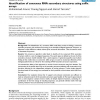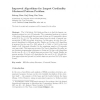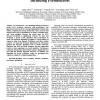105
Voted
CLEIEJ
2006
15 years 15 days ago
2006
Pseudoknots are a frequent RNA structure that assumes essential roles for varied biocatalyst cell's functions. One of the most challenging fields in bioinformatics is the pre...
73
Voted
BMCBI
2006
15 years 15 days ago
2006
Background: Today, there is a growing need in bioinformatics to combine available software tools into chains, thus building complex applications from existing single-task tools. T...
BMCBI
2006
15 years 15 days ago
2006
Background: The identification of a consensus RNA motif often consists in finding a conserved secondary structure with minimum free energy in an ensemble of aligned sequences. How...
101
click to vote
BMCBI
2010
15 years 17 days ago
2010
Background: To understand an RNA sequence's mechanism of action, the structure must be known. Furthermore, target RNA structure is an important consideration in the design of...
108
Voted
BIOCOMP
2006
15 years 1 months ago
2006
- In this study, a context-sensitive grammar is suggested to model various forms of RNA secondary structures, especially pseudoknots. Comparing with a conventional context-free gra...
107
click to vote
WABI
2005
Springer
15 years 6 months ago
2005
Springer
Abstract Baharak Rastegari and Anne Condon Department of Computer Science, University of British Columbia Abstract. Accurate prediction of pseudoknotted RNA secondary structure is ...
ISAAC
2005
Springer
15 years 6 months ago
2005
Springer
Abstract The 2-Interval Pattern problem is to find the largest constrained pattern in a set of 2-intervals. The constrained pattern is a subset of the given 2-intervals such that ...
101
click to vote
ICPP
2006
IEEE
15 years 6 months ago
2006
IEEE
RNA pseudoknot prediction is an algorithm for RNA sequence search and alignment. An important building block towards pseudoknot prediction is RNA secondary structure prediction. T...
101
click to vote
ISBRA
2007
Springer
15 years 6 months ago
2007
Springer
Abstract. The lattice approach to biological structural analysis was made popular by the HP model for protein folding, but had not been used previously for RNA secondary structure ...
108
Voted
BIBE
2007
IEEE
15 years 6 months ago
2007
IEEE
-We demonstrate a new algorithm named FlexStem to predict RNA secondary structures with pseudoknots. Our approach is based on the free energy minimization criterion, and utilizes a...



